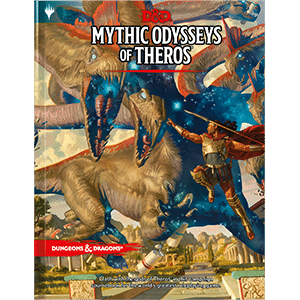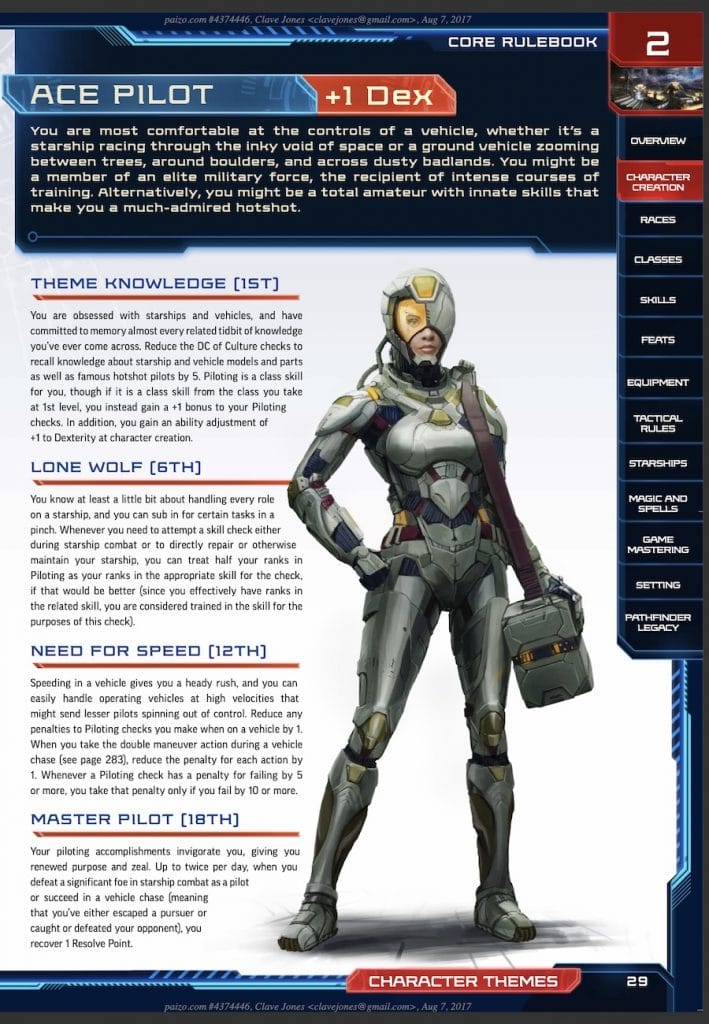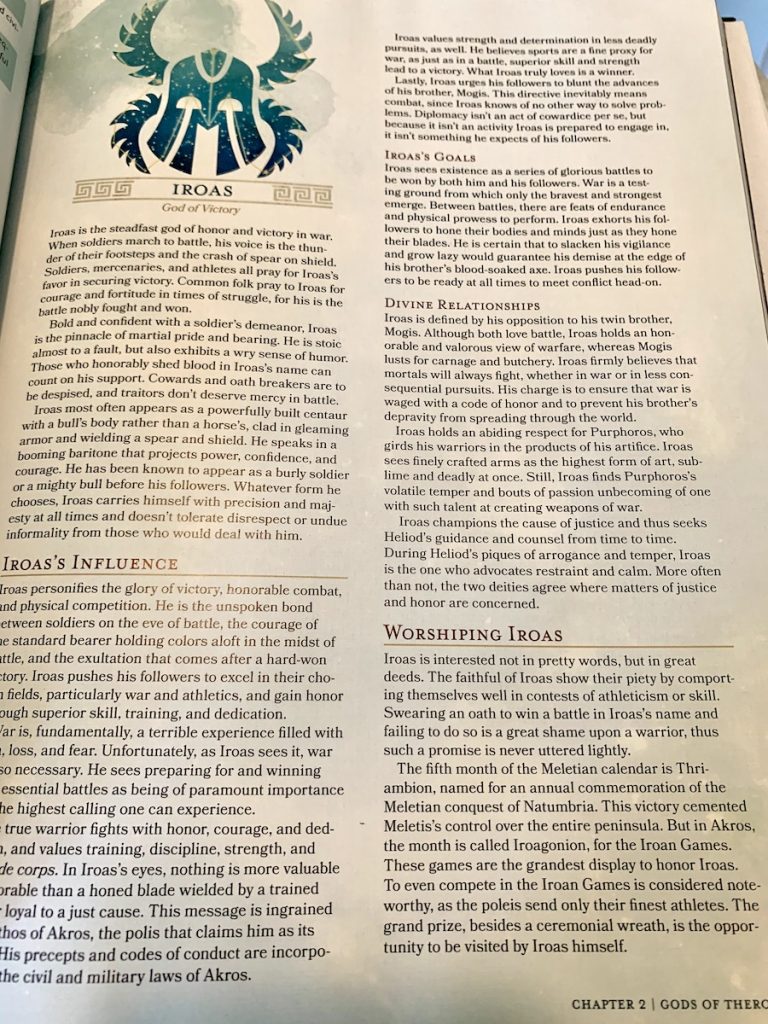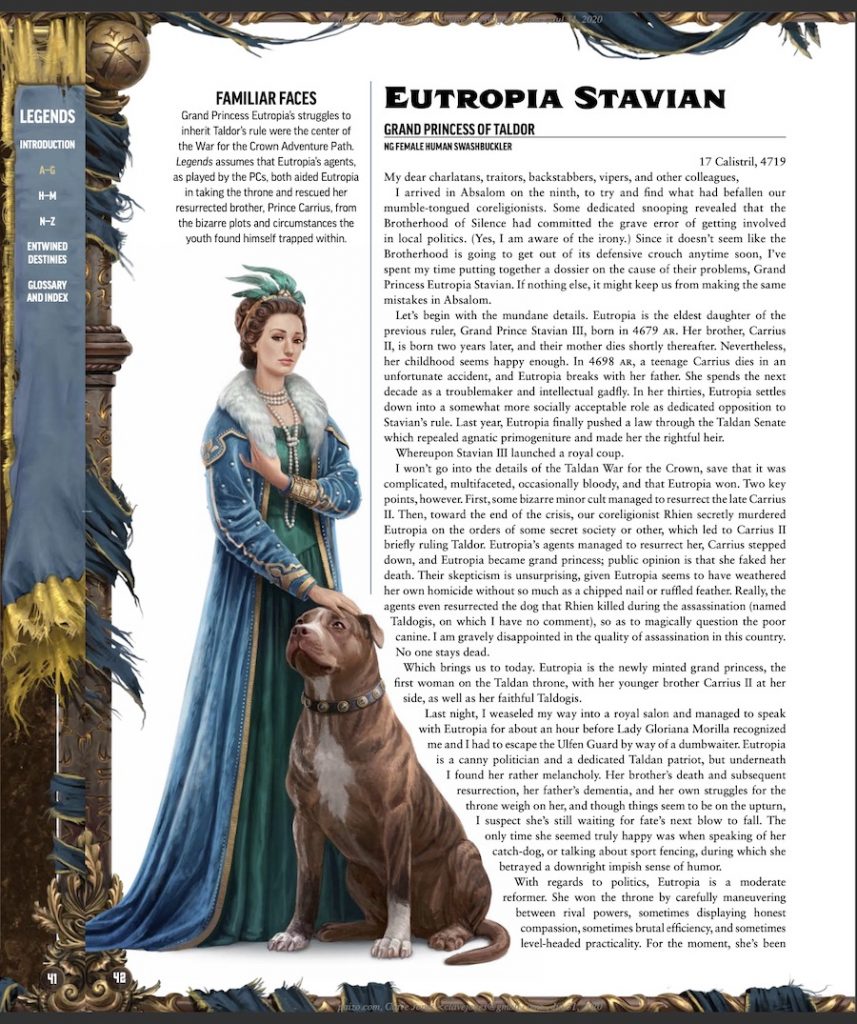I know squat from jack when it comes to Magic: The Gathering, which is a heck of a way to start a review of D&D’s Mythic Odysseys of Theros, the latest sourcebook from Wizards of the Coast that brings more Magic lore into Dungeons & Dragons.

That said, this will be my longest review ever for a D&D product. I’ll go into:
- The book’s contents & art direction,
- the business motivations of WotC,
- current personnel,
- my failures and biases as a reviewer,
- setting support vs. adventure support, and, finally,
- I’ll try to answer the question of who this book is supposedly for.
In fact, I’ve been wrestling with this review three weeks past my deadline and I need to be upfront about why. In short, I’m going to give Mythic Odysseys of Theros a poor review, so I want to be as thorough, objective, and fair as to why.
Let’s get started by outlining the basic contents of the book.
Mythic Odysseys of Theros: Contents
Mythic Odysseys of Theros is 256 pages. The lead designers are F. Wesley Schneider and James Wyatt, both veterans of old school D&D and core contributors in today’s modern RPG scene. If you are familiar with these two at all, you already know their talent.
As a result, the book shines when examining overall structure and content. The text is mostly clean, understandable, and snappy, save for a tendency at times to be supercilious, perhaps as an intentional homage to the Ancient Greek influences on the setting.
It’s a fine book to simply read and it is filled with gorgeous art, as usual for a D&D 5e product, but don’t expect it to be immediately accessible. I’m mostly unfamiliar with Magic: The Gathering, so Theros didn’t quite enthrall me until chapter 4. In contrast, the other Magic setting book for D&D–Ravnica–clicked fully for me as early as the intro.
- Chapter 1 deals with character creation. It adds races that aren’t currently a part of D&D 5e but are integral to Magic. Further, it introduces the concept of Heroic Drive and Supernatural Gifts. More on this later.
- Next is 50 pages detail the Gods of Theros. While this might seem like a lot, the gods are the central component of the setting of Theros. If you are familiar with Greek mythology, then all this will feel very familiar, as, in many ways, only the names have changed.
- Chapter 3 attempts to root the setting in physical space. We learn that cities are called poleis, a rough analogue the the city-states of Ancient Greece, where “Akros” approximates Sparta and “Meletis” is Athens. I feel asleep twice reading these 25 pages; an admission that sounds more snarky in written form than I wanted it to as it was simply me expressing that the locales of Theros didn’t capture my imagination the way fantasy locales typically do.
- Next, Mythic Odysseys of Theros gives some DM instruction. “God-based adventures” is the core hook of Theros, so chapter 4 offers some help to DMs who are looking for a little “divine assistance” in running adventures in the setting. But DMs will have to take things on faith because there is little in way of help, even accounting for the included adventure that takes players from level 1 to–get this–level 2.
- Chapter 5 is a thin 8 pages of magical items and treasure.
- The book closes with monsters, which is always fun. In these 50 pages we learn that Theros only has Red and Blue Dragons, Cerberus patrols the Tartyx River, the historical Colossus of Rhodes actually walks, Harpies and Hydras are a handful, and Tromokratis the kraken is released. In short, if you grew up marveling at Clash of the Titans as a kid, then the monsters of Theros will be wholly familiar to you.
Mythic Odysseys of Theros’ Place in D&D
I really wanted to enjoy this book. I try hard not to be type of person who is let down that kittens don’t grow up to be adorable baby pandas, so I’m not reflexively looking to be disappointed. But I will concede that my expectations may have been elevated because I enjoyed Guildmaster’s Guide to Ravnica, the first Magic setting book, released just a couple years ago. Here’s what I said about that book:
“I enjoyed the book immensely. It’s a great blend. The D&D side of me felt very comfortable with the structure of the book. I felt like Ravnica is a great addition to 5th edition. The Magic side of me was curious, intrigued, and enthused. I won’t be buying Magic cards any time soon, but I’m certainly engaged in the lore of the game now.
… I don’t know what I’ll do with the book long-term, but we’ll see. Isn’t enjoying something in the moment reward enough in itself? Besides, we’ll soon see if this moment will stretch into future mashups between D&D and Magic.”
In short, I thought Ravnica would make more noise than it did. And I admit that it has likely done well financially for WotC, as all D&D books have done, but I swear I don’t hear a peep about the book.
I also admit that I obviously don’t have access to exact WotC sales numbers, although us reviewers have a few tricks up our sleeves when we are trying to educate our guesses. We add up Amazon sales data, channel checks (meaning we look for success indicators in places like Barnes and Noble), Twitter engagement, Google search activity, and the amount of dust on the books at our FLGS in sort of an alchemists brew that offers clues into the strength of a product.

In short, Ravnica seems to be doing fine. Not bad, yet certainly not among the most popular D&D 5e books. So, if Ravnica is middle of the road, why did WotC follow up with another Magic book so soon thereafter? My guess is this is another attempt to convert Magic players into D&D players, a low-cost endeavor because WotC owns both properties.
Taken another way, if I’m a new D&D player, why do I pull Mythic Odysseys of Theros off the shelf? How it is described to me? What’s the pitch?
Mythic Odysseys of Theros breaks the first rule of new products. It struggles with the question, “Who is this for?”
If I’m a Magic player interested in D&D, I’ll reach first to Ravnica, the better book and more engaging setting. If I’m a dungeon master, I’m looking for adventure support, not another pantheon. And if I’m a long-time player, I’m looking for a different setting, like Dark Sun or Spelljammer, or simply to go broader into the Forgotten Realms, the setting with the largest amount of established lore and adventure support.
To be clear, I don’t care if WotC brings back Greyhawk or Dragonlance, as many of those old settings feel just that: Old. I fully understand WotC wanting to leverage Magic in order to attract the attention of their core audience. And since Eberron and Magic settings have always been produced fully within WotC, there are likely fewer legal entanglements, meaning less potential royalty disbursements. That’s up to the lawyers and I’m not one of those.
Further, I fully acknowledge the cynicism in this statement, but I almost wonder if Mythic Odysses of Theros is a book that will serve as a companion piece for fans to immerse themselves in lore as they watch actors and entertainers play in Theros on their favorite streaming service, because it doesn’t feel like a fully energetic product designed to foster widespread play itself.
But most of the above is more of a “meta” discussion around Theros. What about the details of the book? For that discussion, I don’t think it’s unfair to compare / contrast the content with other popular books within the roleplaying genre.
The mechanic of Heroic Drive and Supernatural Gifts is an interesting concept, in that it allows a titch more character customization in addition to a sense of fun that comes through a power fantasy. But the implementation is flat and lifeless.
Sure, it’s like comparing apples and bananas, but let’s contrast that to the visual implementation of Themes in Paizo’s Starfinder, as shown below.
Next, let’s talk about the presentation of the core of the setting material, which for Theros, is certainly the pantheon of Gods. Pathfinder 2nd Edition recently released a patheon book, plus they released another book in that Lost Omens line just this month.
Lost Omens Legends is an interesting comparison to Theros when you focus on how information is presented. Lost Omens books read largely as a narrative. As a result, reading it is a breeze and the characters come alive, imaginatively popping off the pages.
In comparison, the characters in Theros fall flat and lack imagination. There is little in the way of life to them, something, sadly, which could be used to describe the entire book. Flat and lifeless.
So, who is D&D’s Mythic Odysseys of Theros for? Well, folks who reflexively purchase each and every D&D 5e book. And if you have purchased every D&D 5e book, you may have noticed a something interesting of late.
Guildmaster’s Guide to Ravnica, the first Magic: The Gathering setting book for D&D 5e, was released just a couple years ago in November of 2018. Since then we have seen the following D&D 5e hardcovers:
- Ghosts of Saltmarsh (May 2019) – An adventure book that retooled 7 D&D adventures from yesteryear and kinda sorta introduced the classic Greyhawk setting into D&D 5e.
- Acquisitions Incorporated (June 2019) – An excellent and humorous tie-in book with Penny Arcade, one of WotC’s long-time multimedia partners. It serves as a sourcebook for a new way to play in the Forgotten Realms via commerce, professions, and organizations.
- Baldur’s Gate: Descent into Avernus (Sept 2019) – Adventure book.
- Eberron: Rising from the Last War (Nov 2019) – Setting book of pulpy high adventure.
- Explorer’s Guide to Wildemount (March 2020) – A setting book tie-in with Critical Role, WotC’s most popular multimedia partner.
So, in roughly two calendar years–including the two Magic books–WotC has splintered their player base by producing 6 setting books of various types in addition to one full adventure book. Not exactly meat and potatoes.
It’s a mystifying strategy unless you have a cynical take, which is that D&D 5e is now 6+ years old, which is very mature as product cycles go, and WotC is now wholly focused on recouping all their early R&D expenditures by leveraging high profit products from their key media partnerships.
Because if Mythic Odysseys of Theros is presented to any other audience other than accounting, it’s just not that exciting.
[Disclosure: Wizards of the Coast provided Nerds on Earth with a copy of the book in exchange for an honest review.]





